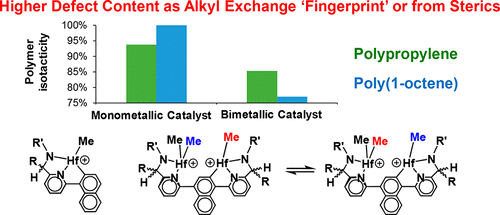当前位置:
X-MOL 学术
›
Macromolecules
›
论文详情
Our official English website, www.x-mol.net, welcomes your
feedback! (Note: you will need to create a separate account there.)
Catalyst Nuclearity Effects on Stereo- and Regioinduction in Pyridylamidohafnium-Catalyzed Propylene and 1-Octene Polymerizations
Macromolecules ( IF 5.1 ) Pub Date : 2018-03-15 00:00:00 , DOI: 10.1021/acs.macromol.8b00181 Yanshan Gao 1 , Xia Chen 1, 2 , Jialong Zhang 1, 3 , Jiazhen Chen 1 , Tracy L. Lohr 1 , Tobin J. Marks 1
Macromolecules ( IF 5.1 ) Pub Date : 2018-03-15 00:00:00 , DOI: 10.1021/acs.macromol.8b00181 Yanshan Gao 1 , Xia Chen 1, 2 , Jialong Zhang 1, 3 , Jiazhen Chen 1 , Tracy L. Lohr 1 , Tobin J. Marks 1
Affiliation

|
In comparison to monometallic controls, bimetallic olefin polymerization catalysts often exhibit superior performance in terms of higher polyolefin Mw, higher comonomer incorporation, and higher polar comonomer tolerance. However, using cooperating catalyst centers to modulate stereoselectivity in α-olefin polymerizations is relatively unexplored. In this contribution, the monometallic Hf(IV) complex, L1-HfMe2 (catalyst A, L1 = 2,6-diisopropyl-N-{(2-isopropylphenyl)[6-(naphthalen-1-yl)pyridin-2-yl]methyl}aniline), and homo-bimetallic Hf(IV) complexes, L2-Hf2Me5 (catalyst B) and L2-Hf2Me4 (catalyst C) (L2 = N,N′-{[naphthalene-1,4-diylbis(pyridine-6,2-diyl)]bis[(2-isopropylphenyl)methylene)]bis(2,6-diisopropylaniline}), are activated with Ph3C+B(C6F5)4– and investigated in propylene and 1-octene homopolymerizations. In propylene polymerizations, the conformationally flexible catalyst B-derived bimetallic dicationic catalyst produces higher Mw polypropylene (up to 7.8×), higher total stereo- and regiodefect densities (up to 3.5×), and lower Tm (by as much as ∼14 °C) versus the monometallic catalyst A-derived control. In 1-octene polymerizations, the conformationally flexible catalyst B-derived bimetallic dicationic catalyst induces greatly reduced isotacticity (23% reduction in [mmmm]) versus the catalyst A-derived monometallic control ([mmmm] > 99%). Interestingly, conformationally flexible catalyst B-derived cationic bimetallic Hf catalysts are also known to undergo rapid intramolecular/intermetal methyl exchange and to exhibit strong Hf···Hf cooperative enchainment effects in ethylene homo- and copolymerizations. Steric effects and intramolecular intermetal chain transfer likely both contribute to the increased isotactic polyolefin stereo- and regiodefect content.
中文翻译:

吡咯酰胺基Pro催化的丙烯和1-辛烯聚合中催化剂核对立体和区域诱导的影响
与单金属对照相比,双金属烯烃聚合催化剂通常在较高的聚烯烃M w,较高的共聚单体掺入和较高的极性共聚单体耐受性方面表现出优异的性能。然而,在α-烯烃聚合中使用协同的催化剂中心来调节立体选择性是相对未开发的。在这种贡献中,单金属Hf(IV)配合物L 1 -HfMe 2(催化剂A,L 1 = 2,6-二异丙基-N -{(2-异丙基苯基)[6-(萘-1-基)吡啶- 2-基]甲基}苯胺)和均双金属Hf(IV)配合物L 2 -Hf 2 Me 5(催化剂B)和L 2 -Hf 2 Me 4(催化剂C)(L 2 = N,N '-{[萘-1,4-二基双(吡啶-6,2-二基)]双[(2-异丙基苯基)亚甲基) ]双(2,6-二异丙基苯胺}),进行的Ph活化3 ç + B(C 6 ˚F 5)4 -和在丙烯和1-辛烯均聚的影响。在丙烯聚合中,构象柔性催化剂B衍生的双金属二元型催化剂产生更高的M w聚丙烯(最高7.8倍),更高的总立体缺陷和区域缺陷密度(最高3.5倍)和更低的T m(最高约14°C),与源自单金属催化剂A的对照相比。在1-辛烯聚合反应中,与衍生自催化剂A的单金属对照物([ mmmm ]> 99%)相比,构象柔性催化剂B衍生的双金属二元二元催化剂大大降低了全同立构规整度([ mmmm ]降低了23 %)。有趣的是,构象柔性催化剂B衍生自阳离子的双金属Hf催化剂也经历了快速的分子内/金属间甲基交换,并在乙烯均聚和共聚反应中表现出很强的Hf··Hf协同键合作用。立体效应和分子内金属间链转移都可能导致等规聚烯烃立体和区域缺陷含量的增加。
更新日期:2018-03-15
中文翻译:

吡咯酰胺基Pro催化的丙烯和1-辛烯聚合中催化剂核对立体和区域诱导的影响
与单金属对照相比,双金属烯烃聚合催化剂通常在较高的聚烯烃M w,较高的共聚单体掺入和较高的极性共聚单体耐受性方面表现出优异的性能。然而,在α-烯烃聚合中使用协同的催化剂中心来调节立体选择性是相对未开发的。在这种贡献中,单金属Hf(IV)配合物L 1 -HfMe 2(催化剂A,L 1 = 2,6-二异丙基-N -{(2-异丙基苯基)[6-(萘-1-基)吡啶- 2-基]甲基}苯胺)和均双金属Hf(IV)配合物L 2 -Hf 2 Me 5(催化剂B)和L 2 -Hf 2 Me 4(催化剂C)(L 2 = N,N '-{[萘-1,4-二基双(吡啶-6,2-二基)]双[(2-异丙基苯基)亚甲基) ]双(2,6-二异丙基苯胺}),进行的Ph活化3 ç + B(C 6 ˚F 5)4 -和在丙烯和1-辛烯均聚的影响。在丙烯聚合中,构象柔性催化剂B衍生的双金属二元型催化剂产生更高的M w聚丙烯(最高7.8倍),更高的总立体缺陷和区域缺陷密度(最高3.5倍)和更低的T m(最高约14°C),与源自单金属催化剂A的对照相比。在1-辛烯聚合反应中,与衍生自催化剂A的单金属对照物([ mmmm ]> 99%)相比,构象柔性催化剂B衍生的双金属二元二元催化剂大大降低了全同立构规整度([ mmmm ]降低了23 %)。有趣的是,构象柔性催化剂B衍生自阳离子的双金属Hf催化剂也经历了快速的分子内/金属间甲基交换,并在乙烯均聚和共聚反应中表现出很强的Hf··Hf协同键合作用。立体效应和分子内金属间链转移都可能导致等规聚烯烃立体和区域缺陷含量的增加。











































 京公网安备 11010802027423号
京公网安备 11010802027423号